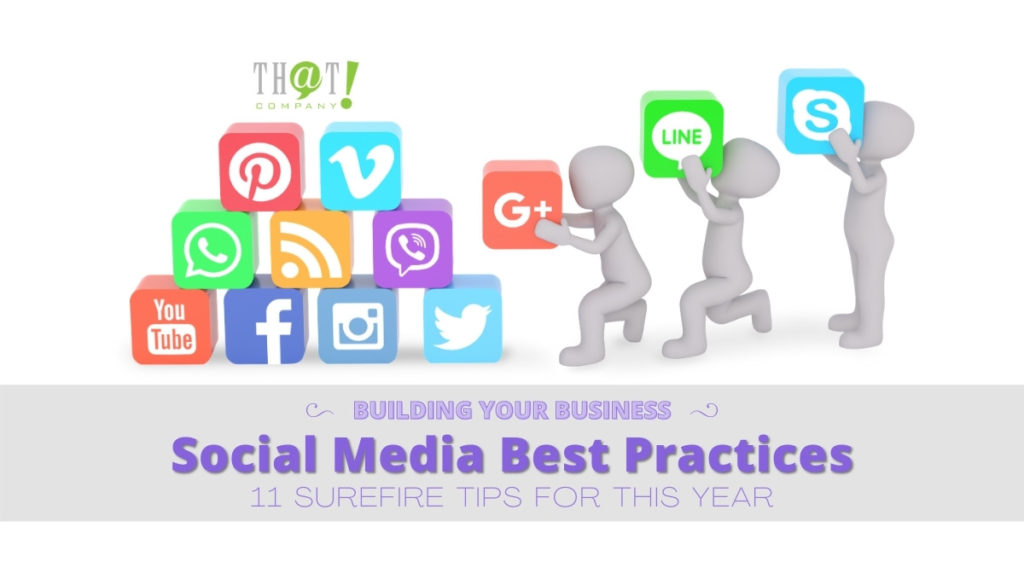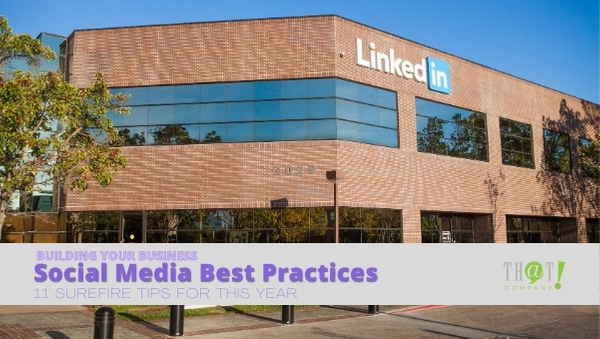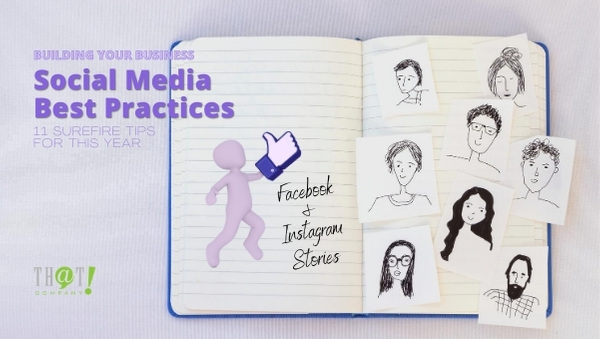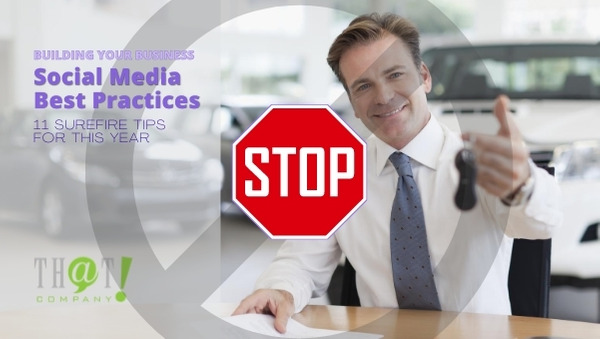 Social Media best practices are ever-changing and those that can stay on top of those changes and adapt will be the ones to dominate the market. Keep in mind that social media may be where your customers and clients are, but they are there and not looking for products and services. Interruptive marketing is a different style of marketing and takes a unique strategy to be successful. That strategy also needs to be fluid and adjusted to how social media best practices change and adjust. Your clients need change and adjust as time goes on and so does your marketing.
Social Media best practices are ever-changing and those that can stay on top of those changes and adapt will be the ones to dominate the market. Keep in mind that social media may be where your customers and clients are, but they are there and not looking for products and services. Interruptive marketing is a different style of marketing and takes a unique strategy to be successful. That strategy also needs to be fluid and adjusted to how social media best practices change and adjust. Your clients need change and adjust as time goes on and so does your marketing.
Let’s look at some of the latest trends that are happening within Social Media Marketing so that we can understand the changing dynamic of this powerful marketing toolset. Here is a list of 11 unique challenges and strategies that need to be addressed if you want to make the most of your marketing efforts.
#1: Why Are Advertisers Bailing on Facebook Ads
Advertisers are going to be looking elsewhere to spend their ad budgets as Facebook is not only getting more expensive, but they are also getting more difficult to optimize due to them limiting how you can target.
[bctt tweet=”Facebook seems to be changing and marketers need to change with it.” username=”ThatCompanycom”]Facebook was prime for clients with low average ticket costs or low ad spend but with this new pricing change, they may be losing their primary benefit of utilizing Facebook for paid advertising. The statement, “He that can pay the most, wins” has never been truer. Combine that with the more difficult targeting and it very well may set back the platforms’ ability to keep smart advertisers.
Take Effective Countermeasures
To counter the increase in CPMs, you need to optimize better and more often. No more setting and forgetting. There are numerous ways to do this. A/B testing and refreshing content is one way to accomplish this. By rotating ad copy, creative, audiences, offers, and objectives you can reduce ad burn out.
Another way to help increase ROAS (Return On Ad Spend) is to increase your average tickets and client purchases. Too many businesses are afraid to increase pricing. They may believe they need to be cheaper than the competition to get the sale. But the market is turning. Sure, you will always have the customers whose main hot point is the price. But today, more and more are realizing that you really do get what you pay for. Customers are looking beyond price points now. They are considering the value of what they are getting for the amount they are paying.
One of the best ways to counter Facebook’s price increase is to optimize not only for the initial sale but to measure true ROAS. True ROAS is the real worth of a customer to your business when you acquire them via Facebook and Instagram advertising. It includes their value as a repeat customer who spends multiples of what they spent when they first bought from you. By using the lifetime value of your customers, you will get a true measure of your ROAS. This allows you to make adjustments that make sense for the long term.
Facebook seems to be changing and marketers need to change with it. As a leading channel of social media, best practices for advertising need to be flexible. We need to adapt to not just the price increase, but the more difficult targeting. Ultimately, we may consider putting effort into more rewarding platforms.
#2: Is LinkedIn Viable as a Paid Platform?
 Getting traffic at the end of the year has always been expensive and each year is no different. LinkedIn advertising costs are currently high and there was a big bump in CPC (cost per click) when they released objective-based advertising in March 2019. Maybe LinkedIn’s objective-based advertising made for a more competitive marketplace or maybe rising Facebook ad costs have pushed more advertisers to LinkedIn. If it drops, we’ll know whether it was just due to seasonality.
Getting traffic at the end of the year has always been expensive and each year is no different. LinkedIn advertising costs are currently high and there was a big bump in CPC (cost per click) when they released objective-based advertising in March 2019. Maybe LinkedIn’s objective-based advertising made for a more competitive marketplace or maybe rising Facebook ad costs have pushed more advertisers to LinkedIn. If it drops, we’ll know whether it was just due to seasonality.
So how do you get the best ROI (Return on Investment) using LinkedIn?
Bidding Advice
Well, I always recommend that you bid on CPC regardless of the ad format because it presents the lowest risk. Additionally, bidding by engagement or impressions are higher about 90% of the time compared to CPC bids.
To effectively bid CPC on LinkedIn, you need to start small. The reason is that LinkedIn will not tell you what the minimum bid is, so start really low. LinkedIn will then inform you that your bid is too low and then tell you what the minimum bid is. Now you can set your starting bid to the minimum. Then increase when you need more traffic. But grow it slowly and watch your metrics. Be sure to disregard their bidding recommendations, remember they are trying to get more money out of you as well. Avoid using auto-bidding, it’s crazy how expensive it is. They are capitalizing on your laziness.
Lastly, stick with your selected audience. Proven social media best practices indicate you should not dilute your traffic by selecting their audience’s expansion. That function just doesn’t seem as fine-tuned as it should be.
#3: Video Killed the Radio, is Traditional Digital Marketing its Next Target?
Facebook has more than 7 million advertisers and shrinking available inventory. The ever-increasing costs of ads across every major social platform will encourage marketers to look in other directions and get more creative.
It is stated that 80% of global internet traffic will be attributed to videos by 2021. And seeing that YouTube is only topped by Google as the biggest website (even bigger than Facebook), it is apparent that advertisers neglecting this marketing venue are going to fall behind their competition.
#4: 2020 Social Media Best Practices Indicate Stories Will Take Over the Lead in Facebook and Instagram Content
Stories are a great way to grab users’ attention. They add a touch of the human spirit to your social marketing. The Facebook and Instagram Stories content will continue to grow in popularity throughout 2020. So much so that the regular feed will noticeably slow down. It is quite feasible that both Facebook and Instagram may start rolling out more robust tests of its blended feed and Stories format. Initial format changes were not well-received by users, who seem to dislike the alterations. However, Social Media knows the direction is inevitable, so they may start with smaller updates to not rattle the cages too much.
 One change that Facebook has done to the mobile app has been to make the Stories “cards” bigger and more prominent throughout the regular news feed. Facebook also continues to make it easier and more enticing for users to publish content to Stories by sharing daily memories and automatically publishing feed posts to Stories as well.
One change that Facebook has done to the mobile app has been to make the Stories “cards” bigger and more prominent throughout the regular news feed. Facebook also continues to make it easier and more enticing for users to publish content to Stories by sharing daily memories and automatically publishing feed posts to Stories as well.
Looking back at the transitioning period to understand why the Stories format is being pushed so heavily.
In July 2016, on the second quarter 2016 earnings call, Facebook CFO Dave Wehner declared that the company was running out of places in the news feed to show people ads. To help mitigate this max ad load, Facebook spun up ads on Instagram in 2018. But soon the ad load started to max out there, too.
This means that Facebook must find new opportunities to place ads in order to maintain revenue growth. Those new places include Stories, video ad breaks, and Messenger ads, among others.
The future of Facebook’s news feed has been in question ever since Mark Zuckerberg published his 3,200-word privacy manifesto, declaring that the company would be pivoting away from permanent public posts and more toward private secure messaging.
Consider how incredibly easy it is for users to consume content in the Stories format. Tap, swipe, tap, swipe. The user is in total control. They can view as little or as much of any individual account’s stories as they wish. Also, creators can publish an abundance of stories and not worry about cluttering up their followers’ feeds. And with the 24-hour shelf-life of a story, creators must keep producing content, which means more inventory for ad placement.
Utilizing Stories as another ad platform just makes sense, and there’s plenty of content that can take advantage. On Facebook’s third-quarter 2019 earnings call on October 30, COO Sheryl Sandberg mentioned that of the more than 7 million advertisers across all the Facebook family of apps, there are already 3 million advertising across Facebook, Instagram, and Messenger Stories.
Taking Advantage of Telling Your Story
Smart brands/businesses would do well to ensure they have a solid Stories strategy for 2020 with daily images, micro-videos, and content that audiences value. Among top social media best practices is to include interactive elements such as polls, quizzes, slides, questions, and donations in your stories. People love to touch their phones. Some studies show that people touch their phones over 2,600 times a day and extreme cell phone users (in the top 10%) touch their phones as much as 5,400 times daily. That interaction is what will make the users notice you.
Other notable trends and changes advertisers should monitor is any new ad unit and/or ad placement options that Facebook and Instagram may roll out. These include ads in search results on Facebook and ads on Instagram Explore. Video content will also continue to grow across all social platforms. Remember number 3? Video is going to take over. The amount of information you can convey and the human touch that video adds will make it an easy win for all those that take advantage. Get creative!
#5: Among the Social Media Best Practices Today Is a Shift to Personalized Conversation Channels
I believe in 2020, social media best practices will include brands shifting to various forms of personalized messaging. This means more advertisers are moving into private conversation channels.
Brands that haven’t previously focused on relationship marketing techniques will adjust. They will now either spend more on their pay-to-play model or dive into building and hosting community conversations. These create brand advocates and support a belonging vs. buying mindset.
The latter will strengthen the core of their marketing— their website. They will create stronger, faster customer relationships online with automated processes. These will include conversational marketing via chat as well as personalized experiences with dynamic ads, video emails, and text.
To build up deeper connections with their client base, brands will put more heart and humanity into their brand story. Brands will align with feel-good causes and take a strong stance on their core beliefs. They will reach out to like-minded individuals and build stronger relationships with clients and consumers to ensure a more solid client foundation.
Additionally, businesses will increase the adoption of native tools, such as convenience-based integrations. These will help streamline the process and make it easier for their audience to become clients:
- Messenger subscriptions
- Appointment setting
- Purchases on Facebook
- Shopping within stories
In 2020, a social media best practice is to convey a company’s story that can be felt by the users. The process of doing business must be easy for companies to win, keep, and activate their audience into becoming brand advocates.
#6: Stop Looking Like You Are Marketing to Them!
 Why does most social media marketing fail? Because it looks like marketing. Oversaturation of marketing is making people sick of it. They go onto social media channels and the LAST thing they want is someone to try and market to them. No longer can you just use templated images and designs to grab the attention of your user base. No more typical “Happy (insert lame holiday) Day!” and then wait for those leads and sales to just roll right in. You must get creative.
Why does most social media marketing fail? Because it looks like marketing. Oversaturation of marketing is making people sick of it. They go onto social media channels and the LAST thing they want is someone to try and market to them. No longer can you just use templated images and designs to grab the attention of your user base. No more typical “Happy (insert lame holiday) Day!” and then wait for those leads and sales to just roll right in. You must get creative.
Social media is saturated and the best marketing strategies will dominate the market share and leave others begging. You need to understand a few things about the way people have changed and how to reach them via current Social Media Best Practices in Advertising.
- Know your ideal customer and what content they will truly enjoy looking at and interacting with.
- Where to put this content to attract, convince, and convert your audience.
- What the decision-making process your audience goes through to identify and choose a provider to help them with the problem they may have and that you can help solve.
Those few things will go a long way into creating a social media campaign that works. Choosing your correct audience and narrowing that down is only the first step, not your entire marketing plan. You must generate excitement and interaction.
So, stop making that standard template-based garbage that your competitors are also doing. Be different and stand out above them.
#7: Don’t Spread Yourself Too Thin
The social media marketing industry changes fast and it is not slowing down, it’s speeding up. You need to stay ahead of your competition.
Advertising costs are rising and as it is a primary revenue generator, will continue to do so. You need to get better at your marketing, make it perform, and let it do the work for you to stay ahead.
Platform-specific strategies will be key to the success of your marketing campaigns. You can’t just continue to use your generic messaging across all platforms.
Your Twitter audience isn’t the same as your Instagram audience, and neither are the same as your YouTube audience. The audiences behave differently and therefore your messaging needs to adapt to the audience.
Take the time to master the algorithm on one platform at a time, and make sure you can put a reasonable amount of focus into every platform you manage.
#8: Niched Marketing
You want quality over quantity. Quality will get you the clients that pay you. Quantity will get you the people that will consume your budget and energy. People talk about ROI and look at revenue and budget numbers. Few evaluate the complete picture. How much time does your company waste on junk leads? You want quality despite what some fancy reports and ROI numbers may show you.
How can your company make the shift needed to truly be successful?
Among 2020 social media best practices is specialization. Pick one thing you want to be known for and stick to it!
Choose two platforms and excel on them. Choose these platforms based on your ideal client, your best-performing content to date, and the platform demographics. Learn what it takes to target your core clients within these platforms.
Now create a solid hashtag and keyword strategy around your one thing and keep your marketing hyper-focused on it.
Don’t focus on what your competition is doing and mirror it. You will never get ahead of them if you do. Be you and be what your clients want and need.
#9: 2020 Social Media Best Practices That Aren’t: Hot Trending Platforms
Facebook, Instagram, LinkedIn, and Pinterest are not going anywhere. They have stood the test and if anything, they will continue to expand.
I know that a lot of major marketing sites are praising these new hot platforms and really trying to push people to jump on the bandwagon. One of these is TikTok. Its popularity is undoubtedly noticeable and quite appealing. However, I see TikTok following a similar path to that of Snapchat. Yes, TikTok is a hot trend right now with millions of users, but long-term, the user base will move on to a new hot platform just as they moved from Snapchat to TikTok. Companies don’t want to continue to invest resources in the next big thing only to continue to get burned as attention fades and moves elsewhere. Therefore, I think you should continue to focus that energy on Facebook, Instagram, LinkedIn, and Pinterest.
The two platforms to take note of are LinkedIn and Pinterest.
LinkedIn has a long-held reputation of being prohibitively expensive for most small businesses. It is also known for its difficulty in delivering positive results. However, I think that will also change. We’re already starting to see ads on LinkedIn become more effective as they improve the platform for advertisers. As LinkedIn improves its marketing side, look to that platform to really take shape and be extremely useful in targeting your clients.
Pinterest holds a unique position as a social platform. It behaves much more like a search engine than other social media platforms. Meaning your marketing results will behave much like organic results and will linger and continue to drive traffic over time. Traditional social media platforms like Twitter, Facebook, Instagram, and LinkedIn only deliver results for a short period of time.
The life of content on those platforms is very short, days at best. However, on Pinterest, pins can continue to drive traffic for years. It’s that long-term return on investment in the platform that I think will entice marketers who are looking for the best way to invest their limited time and resources.
#10: Authentic Content Beats Strong Marketing, and is a Top Social Media Best Practice for 2020
Too many people have been burned by influencers faking it with perfect photoshoots, and consumers are just not falling for the gimmickry. They are desperate for authenticity.
Social media users can spot forced relationship-building and are tired of these interactions. Find influencers that are genuine and use the products they endorse and are willing to share it with audiences.
Stop looking at the high-volume influencers. Yes, the sheer number of followers they have is appealing but if you think about it, will all those followers really resonate with your messaging and product? Find the smaller influencers that have the audience that you desire as your own clients. Chances are that your marketing efforts will produce better returns.
#11: AI Makes Humanizing Your Brand Imperative
 Artificial intelligence (AI) will be the beginning of the end of marketing as we know it. The social media industry will be affected in a variety of ways.
Artificial intelligence (AI) will be the beginning of the end of marketing as we know it. The social media industry will be affected in a variety of ways.
Data analysis and programming will become the new marketing manager’s role. Not even influencers and content creators are safe because it’s possible to use AI to build an entire persona. As an example, Lil Miquela is a computer-generated influencer with over 2.1 million Instagram followers and is still rapidly growing.
Humanizing your brand is more than a catchy hook. It’s a real business strategy. Every marketer should take it seriously to stay in business. Here are five social media best practices to humanize your brand in the next year.
Step 1:
Create content as if it’s coming from an actual person. When a brand shares content on social media, they’re not just competing with other brands and competitors. They’re competing with everyone on social media for users’ attention, including an individual’s friends, interest groups, and the celebrities they follow. As such, if you simply share pushy messages that sound like they came from a press release, social media users will scroll right past your content until they find something more socially engaging or entertaining.
Brands should try to create content that sounds more like it came from an individual than a corporate entity. Don’t be afraid to adopt a more personal, casual tone. Aim to create content that you would want to engage with yourself. The key is to generate content they will engage with.
Step 2:
Personally, reply to the conversations. If someone comments on your content, don’t send them a copy-and-paste response. Instead, treat that message more like a mailed letter and respond in a personal way.
You can also jump into conversations others are having online. To visualize this, if you’re a real estate agent and you see someone talking about things to do in your city, chime in with a personalized response about what you think that person might like to do, rather than pitching your real estate services.
Give those conversations room to naturally evolve. Eventually, a personal conversation can turn into a more business-focused conversation initiated by the customer. It’s like a referral business, only you’re building the relationship yourself in order to be your own referrer. Use both sides of your humanity, you are a person and yet you are a business.
Step 3:
Utilize your employees. They are the best ambassadors. Try showcasing what a day in the life of different employees at your company is like. Build that personal connection with your consumer by having them relate to your employees. You can also share more content about company events and employee initiatives to help consumers connect with your brand on a personal level.
Today’s consumers don’t simply want to purchase from a logo. They want to purchase from companies they feel a connection with. Highlighting your employees can help generate that personal connection.
Step 4:
Turn your loyal customers into brand ambassadors. Give a voice to the customers who help make your brand what it is. Encourage customers to submit content as part of a contest you’re running. A restaurant, for instance, could ask customers to share their favorite holiday foods and holiday memories. The restaurant could then choose a winner to receive a free meal and have that story shared on social media.
In doing so, you not only provide a more human element to your marketing, but you can also expand your reach. You can achieve this by leveraging the individual networks your customers have when they share content related to your brand on their own channels. You are most likely to get new engagement when personal connections are involved.
Final Thoughts
In summary, 2020 Social Media Best Practices most definitely include “getting personal.” Be aware, however: Marketing, while extremely powerful and rewarding if done correctly, can be disastrous for brands if they do it incorrectly. Social Media is quite powerful too, and that power can swing either way.
Keep in mind that these are individuals that are on these platforms. They are looking for personal connections. If you want to be successful in marketing to them, understand that you are interrupting their desires and wishes. You should, therefore, tread lightly and carefully. Take advantage of these personal connections to help draw them in closer without being disingenuine. Make your efforts exciting and entertaining and make your audience want to engage with you. Apply these social media best practices with care and make it feel like it is their decision to pursue the business relationship you are looking for.





























